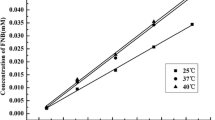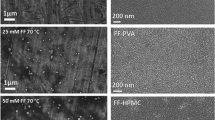Abstract
To determine the effect of the preparation method on the physicochemical properties, such as crystallinity, particle size, solubility and dissolution, of the poorly water-soluble fenofibrate, different samples were prepared from fenofibrate and hydroxypropyl-β-cyclodextrin (HP-β-CD) in a 1:1 molar ratio, by physical mixing, trituration, kneading, solvent-evaporation and spray-drying techniques. The corresponding aqueous solubilities and dissolutions were studied in comparison with that of the drug powder. Characterization of these samples was accomplished using particle size determination, powder x-ray diffraction, differential scanning calorimetry, thermogravimetry, scanning electron microscopy and Fourier transform infrared spectroscopy. All preparations improved the solubility and dissolution of the drug, as compared with that of the drug powder (P < 0.05), in the following descending order of techniques utilized: spray-drying > solvent-evaporation > kneading > trituration > physical mixing. In particular, the aqueous solubility of fenofibrate from the spray-dried preparation was 85.93 ± 6.82 µg/ml, and the dissolution was about 90 % within 20 min. The drug was present in the crystalline state in the physically mixed, triturated and kneaded preparations. However, it was converted into the amorphous state in the solvent-evaporated and spray-dried preparations. The spray-dried preparation having the smallest particle size of 2.44 ± 0.03 μm gave discrete particles. Thus, in the development of a preparation of the poorly water-soluble fenofibrate with HP-β-CD, the preparation method exhibits a significant effect on the physicochemical properties of the drug. Among the various preparations tested in this study, the spray-dried sample, which provided the highest solubility and dissolution of fenofibrate, is strongly recommended for possible administration via the oral route.









Similar content being viewed by others
References
Balfour, J.A., McTavish, D., Heel, R.C.: Fenofibrate. A review of its pharmacodynamic and pharmacokinetic properties and therapeutic use in dyslipidaemia. Drugs 40(2), 260–290 (1990)
Munoz, A., Guichard, J.P., Reginault, P.: Micronised fenofibrate. Atherosclerosis 110, Suppl(0), S45–S48 (1994). doi:http://dx.doi.org/10.1016/0021-9150(94)05375-S
Ming-Thau, S., Ching-Min, Y., Sokoloski, T.D.: Characterization and dissolution of fenofibrate solid dispersion systems. Int. J. Pharm. 103(2), 137–146 (1994). doi:http://dx.doi.org/10.1016/0378-5173(94)90094-9
Vogt, M., Kunath, K., Dressman, J.B.: Dissolution enhancement of fenofibrate by micronization, cogrinding and spray-drying: comparison with commercial preparations. Eur. J. Pharm. Biopharm. 68(2), 283–288 (2008)
Dressman, J., Butler, J., Hempenstall, J., Reppas, C.: The BCS: where do we go from here? Pharm. Technol. 25(7), 68–77 (2001)
Amidon, G., Lennernäs, H., Shah, V., Crison, J.: A theoretical basis for a biopharmaceutic drug classification: the correlation of in vitro drug product dissolution and in vivo bioavailability. Pharm. Res. 12(3), 413–420 (1995). doi:10.1023/a:1016212804288
Badens, E., Majerik, V., Horváth, G., Szokonya, L., Bosc, N., Teillaud, E., Charbit, G.: Comparison of solid dispersions produced by supercritical antisolvent and spray-freezing technologies. Int. J. Pharm. 377(1–2), 25–34 (2009). doi:http://dx.doi.org/10.1016/j.ijpharm.2009.04.047
Cutler, L., Howes, C., Deeks, N.J., Buck, T.L., Jeffrey, P.: Development of a P-glycoprotein knockout model in rodents to define species differences in its functional effect at the blood–brain barrier. J. Pharm. Sci. 95(9), 1944–1953 (2006)
Yoshihashi, Y., Iijima, H., Yonemochi, E., Terada, K.: Estimation of physical stability of amorphous solid dispersion using differential scanning calorimetry. J. Therm. Anal. Calorim. 85(3), 689–692 (2006). doi:10.1007/s10973-006-7653-8
Goddeeris, C., Coacci, J., Van den Mooter, G.: Correlation between digestion of the lipid phase of smedds and release of the anti-HIV drug UC 781 and the anti-mycotic drug enilconazole from smedds. Eur. J. Pharm. Biopharm. 66(2), 173–181 (2007). doi:http://dx.doi.org/10.1016/j.ejpb.2006.10.005
Leuner, C., Dressman, J.: Improving drug solubility for oral delivery using solid dispersions. Eur. J. Pharm. Biopharm. 50(1), 47–60 (2000). doi:http://dx.doi.org/10.1016/S0939-6411(00)00076-X
Perrut, M., Jung, J., Leboeuf, F.: Enhancement of dissolution rate of poorly-soluble active ingredients by supercritical fluid processes: Part I: micronization of neat particles. Int. J. Pharm. 288(1), 3–10 (2005). doi:http://dx.doi.org/10.1016/j.ijpharm.2004.09.007
Antoniadou-Vyza, E., Buckton, G., Michaleas, S.G., Loukas, Y.L., Efentakis, M.: The formation of an inclusion complex of methocarbamol with hydroxypropyl-β-cyclodextrin: the effect on chemical stability, solubility and dissolution rate. Int. J. Pharm. 158(2), 233–239 (1997). doi:http://dx.doi.org/10.1016/S0378-5173(97)00258-5
Müller, B.W., Brauns, U.: Solubilization of drugs by modified β-cyclodextrins. Int. J. Pharm. 26(1–2), 77–88 (1985). doi:http://dx.doi.org/10.1016/0378-5173(85)90201-7
Pitha, J., Pitha, J.: Amorphous water-soluble derivatives of cyclodextrins: nontoxic dissolution enhancing excipients. J. Pharm. Sci. 74(9), 987–990 (1985). doi:10.1002/jps.2600740916
Irie, T., Uekama, K.: Pharmaceutical applications of cyclodextrins. III. Toxicological issues and safety evaluation. J. Pharm. Sci. 86(2), 147–162 (1997). doi:10.1021/js960213f
Loftsson, T., Jarho, P., Masson, M., Järvinen, T.: Cyclodextrins in drug delivery. Expert Opin. Drug Deliv. 2(2), 335–351 (2005)
Miro, A., Quaglia, F., Giannini, L., Cappello, B., Giannini, L., Immacolata La Rotonda, M.: Drug/cyclodextrin solid systems in the design of hydrophilic matrices: a strategy to modulate drug delivery rate. Curr. Drug Deliv. 3(4), 373–378 (2006). doi:10.2174/156720106778558994
Loftsson, T., Brewster, M.E.: Pharmaceutical applications of cyclodextrins. 1. Drug solubilization and stabilization. J. Pharm. Sci. 85(10), 1017–1025 (1996)
Thompson, D.O.: Cyclodextrins— enabling excipients: their present and future use in pharmaceuticals. 14(1), 104 (1997). doi:10.1615/CritRevTherDrugCarrierSyst.v14.i1.10
Connors, K.A.: The stability of cyclodextrin complexes in solution. Chem. Rev. 97(5), 1325–1358 (1997)
Li, S., Purdy, W.C.: Cyclodextrins and their applications in analytical chemistry. Chem. Rev. 92(6), 1457–1470 (1992)
Rekharsky, M.V., Inoue, Y.: Complexation thermodynamics of cyclodextrins. Chem. Rev. 98(5), 1875–1918 (1998)
Higuchi, T., Connors, K.A.: Phase-solubility techniques. Adv. Anal. Chem. Instrum. 4(2), 117–212 (1965)
Patil, J., Kadam, D., Marapur, S., Kamalapur, M.: Inclusion complex system; a novel technique to improve the solubility and bioavailability of poorly soluble drugs: a review. Int. J. Pharm. Sci. Rev. Res. 2(2), 29–33 (2010)
Astakhova, A.V., Demina, N.B.: Modern drug technologies: synthesis, characterization, and use of inclusion complexes between drugs and cyclodextrins (a review). Pharm. Chem. J. 38(2), 105–108 (2004). doi:10.1023/B:PHAC.0000032490.04705.ba
Fernandes, C.M., Veiga, F.J.B.: Effect of the hydrophobic nature of triacetyl-beta-cyclodextrin on the complexation with nicardipine hydrochloride: physicochemical and dissolution properties of the kneaded and spray-dried complexes. Chem. Pharm. Bull. 50(12), 1597–1602 (2002). Tokyo
Sebhatu, T., Angberg, M., Ahlneck, C.: Assessment of the degree of disorder in crystalline solids by isothermal microcalorimetry. Int. J. Pharm. 104(2), 135–144 (1994)
Mehmood Yousaf, A., Wuk Kim, D., Choi, H.-G., Oh, E.: Validation of a highly sensitive RP-HPLC method for quantification of fenofibrate in pure and pharmaceutical dosage forms. Curr. Pharm. Anal. 10(2), 97–104 (2014)
Shah, V.P., Noory, A., Noory, C., McCullough, B., Clarke, S., Everett, R., Naviasky, H., Srinivasan, B., Fortman, D., Skelly, J.P.: In vitro dissolution of sparingly water-soluble drug dosage forms. Int. J. Pharm. 125(1), 99–106 (1995)
Stamm, A., Seth, P.: Fenofibrate pharmaceutical composition having high bioavailabilty. In. Google Patents, (2006). http://www.google.com/patents/US6277405
Sanganwar, G.P., Gupta, R.B.: Dissolution-rate enhancement of fenofibrate by adsorption onto silica using supercritical carbon dioxide. Int. J. Pharm. 360(1–2), 213–218 (2008). doi:http://dx.doi.org/10.1016/j.ijpharm.2008.04.041
Joe, J.H., Lee, W.M., Park, Y.-J., Joe, K.H., Oh, D.H., Seo, Y.G., Woo, J.S., Yong, C.S., Choi, H.-G.: Effect of the solid-dispersion method on the solubility and crystalline property of tacrolimus. Int. J. Pharm. 395(1–2), 161–166 (2010). doi:http://dx.doi.org/10.1016/j.ijpharm.2010.05.023
Konno, H., Handa, T., Alonzo, D.E., Taylor, L.S.: Effect of polymer type on the dissolution profile of amorphous solid dispersions containing felodipine. Eur. J. Pharm. Biopharm. 70(2), 493–499 (2008)
Noyes, A.A., Whitney, W.R.: The rate of solution of solid substances in their own solutions. J. Am. Chem. Soc. 19(12), 930–934 (1897)
Mihajlovic, T., Kachrimanis, K., Graovac, A., Djuric, Z., Ibric, S.: Improvement of aripiprazole solubility by complexation with (2-hydroxy) propyl-β-cyclodextrin using spray drying technique. AAPS Pharm. Sci. Tech. 13(2), 623–631 (2012)
Hancock, B.C., Parks, M.: What is the true solubility advantage for amorphous pharmaceuticals? Pharm. Res. 17(4), 397–404 (2000)
Dias, M.M.R., Raghavan, S.L., Pellett, M.A., Hadgraft, J.: The effect of β-cyclodextrins on the permeation of diclofenac from supersaturated solutions. Int. J. Pharm. 263(1–2), 173–181 (2003). doi:http://dx.doi.org/10.1016/S0378-5173(03)00366-1
Derakhshanian, V., Banerjee, S.: Cyclodextrin inhibits calcium carbonate crystallization and scaling. Ind. Eng. Chem. Res. 51(11), 4463–4465 (2012)
Clas, S.D., Kwong, E., Meisner, D., Vadas, E.B., Winters, C.: Topical polymeric drug delivery system. In. Google Patents, (1997). http://www.google.com/patents/EP0758229A1?cl=en
Upadhye, S.B., Kulkarni, S.J., Majumdar, S., Avery, M.A., Gul, W., ElSohly, M.A., Repka, M.A.: Preparation and characterization of inclusion complexes of a hemisuccinate ester prodrug of Δ9-tetrahydrocannabinol with modified beta-cyclodextrins. AAPS Pharm. Sci. Tech. 11(2), 509–517 (2010)
Chow, A.H., Hsia, C.K., Gordon, J.D., Young, J.W., Vargha-Butler, E.I.: Assessment of wettability and its relationship to the intrinsic dissolution rate of doped phenytoin crystals. Int. J. Pharm. 126(1), 21–28 (1995)
Kawashima, Y., Saito, M., Takenaka, H.: Improvement of solubility and dissolution rate of poorly water-soluble salicylic acid by a spray-drying technique. J. Pharm. Pharmacol. 27(1), 1–5 (1975)
Dai, W.-G., Dong, L.C., Song, Y.-Q.: Nanosizing of a drug/carrageenan complex to increase solubility and dissolution rate. Int. J. Pharm. 342(1), 201–207 (2007)
Mura, P., Cirri, M., Faucci, M., Ginès-Dorado, J., Bettinetti, G.: Investigation of the effects of grinding and co-grinding on physicochemical properties of glisentide. J. Pharm. Biomed. Anal. 30(2), 227–237 (2002)
Srinarong, P., Faber, J., Visser, M., Hinrichs, W., Frijlink, H.: Strongly enhanced dissolution rate of fenofibrate solid dispersion tablets by incorporation of superdisintegrants. Eur. J. Pharm. Biopharm. 73(1), 154–161 (2009)
Yonemochi, E., Kitahara, S., Maeda, S., Yamamura, S., Oguchi, T., Yamamoto, K.: Physicochemical properties of amorphous clarithromycin obtained by grinding and spray drying. European J. Pharm. Sci. 7(4), 331–338 (1999)
Kubo, H., Mizobe, M.: Improvement of dissolution rate and oral bioavailability of a sparingly water-soluble drug, ()-5-[[2-(2-Naphthalenylmethyl)-5-benzoxazolyl] methyl]-2, 4-thiazolidinedione, in Co-ground Mixture with d-Mannitol. Biol. Pharm. Bull. 20, 460–463 (1997)
Purvis, T., Vaughn, J.M., Rogers, T.L., Chen, X., Overhoff, K.A., Sinswat, P., Hu, J., McConville, J.T., Johnston, K.P., Williams III, R.O.: Cryogenic liquids, nanoparticles, and microencapsulation. Int. J. Pharm. 324(1), 43–50 (2006)
Acknowledgments
This work was supported by the National Research Foundation of Korea (NRF) grant funded by the Korea government (MEST) (No. NRF-2012R1A2A2A01045658).
Author information
Authors and Affiliations
Corresponding authors
Rights and permissions
About this article
Cite this article
Yousaf, A.M., Kim, D.W., Cho, K.H. et al. Effect of the preparation method on crystallinity, particle size, aqueous solubility and dissolution of different samples of the poorly water-soluble fenofibrate with HP-β-CD. J Incl Phenom Macrocycl Chem 81, 347–356 (2015). https://doi.org/10.1007/s10847-014-0461-z
Received:
Accepted:
Published:
Issue Date:
DOI: https://doi.org/10.1007/s10847-014-0461-z




